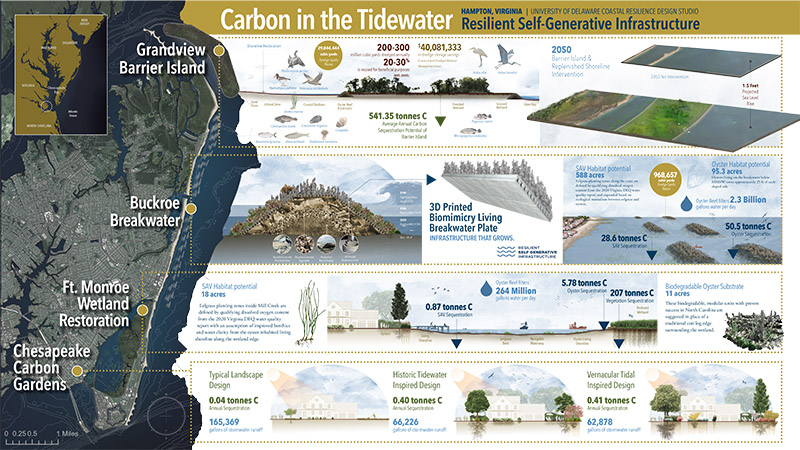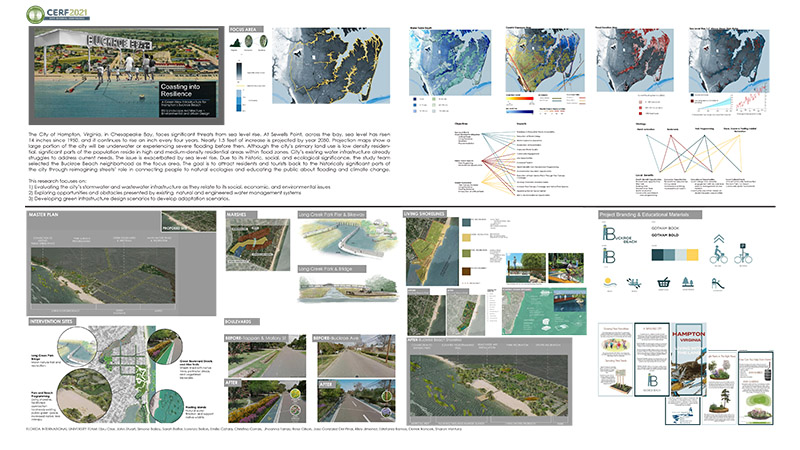Contest Winners
Student design competition creates adaptive flood ideas for Hampton
BY MADELEINE JEPSEN | VIRGINIA SEA GRANT
Four student teams from Florida International University, Penn State, University of Delaware, and Virginia Tech created design ideas focused on six neighborhoods in Hampton, Virginia. The design proposals focused on coastal settlement, ecosystem restoration, flood protection, and economic development for these neighborhoods. Over the last two decades, Hampton has experienced a high rate of climate change-related stresses, like flooding, which is expected to increase in the near future.
The design competition presentations and judging occurred Monday, Nov. 8 during the Coastal and Estuarine Research Federation’s 2021 conference. The design competition was developed over the last two years by co-chairs Jori Erdman, an architectural design professor at James Madison University, and Tiffany Troxler, associate professor and director of the Sea-level Solutions Center at Florida International University, and sponsored by Virginia Sea Grant, Louisiana Sea Grant, Wetlands Watch, Resilient Hampton, and CERF.
The awards were presented by U.S. Rep. Elaine Luria, who emphasized that innovative solutions to sea level rise will improve the daily lives of coastal Virginians in Hampton and beyond.
“My daughter goes to school near downtown Norfolk, and there are days when you can’t pull into the parking lot to pick her up from school. You have to park a couple blocks away and choose your sidewalks carefully to get there, and that’s without any rain,” Luria said. “This is real, and it’s something we deal with every day.”
FIRST PLACE: UNIVERSITY OF DELAWARE
The first-place prize of $2,000 was awarded to the University of Delaware team, whose project, “Carbon in the Tidewater,” proposed four nature-based solutions to protect the city of Hampton: a barrier island near Grandview Nature Preserve, oyster reef breakwaters near Buckroe Beach, wetland restoration at Ft. Monroe, and carbon-storing lawn designs.
SECOND PLACE: PENNSYLVANIA STATE UNIVERSITY
The second-place prize of $1,000 was awarded to the Pennsylvania State University team for their project, “Social and ecological history supporting a resilient Hampton, Virginia,” which examined resilience strategies informed by Hampton’s historical transformations.
HONORABLE MENTION: VIRGINIA TECH
Virginia Tech’s submission, “Advancing Toward a Resilient Hampton 2050 by Supporting Population Mobility,” focused on geospatial, economic, and urban planning strategies to protect Hampton’s assets, identified opportunities for future land use, and innovative policy mechanisms to accommodate the anticipated land loss due to rising seas.
HONORABLE MENTION: FLORIDA INTERNATIONAL UNIVERSITY
Florida International University’s project, “Coasting into Resilience, a Green New Infrastructure for Hampton’s Buckroe Beach,” evaluated Hampton’s stormwater and wastewater infrastructure, and developed green infrastructure for adaptation scenarios.
WATCH: STUDENT TEAM PRESENTATIONS AND JUDGING
Over the course of a semester, each faculty-led student group developed a detailed design plan with justifications, concluding with a project overview presentation and posters at the conference. The designs were presented to a panel of judges representing different perspectives on resilience.
“Our hope in launching this was to think about how we could push the envelope a bit, and facilitate that deeper connection of knowledge and integration between folks in the design world and folks in the coastal ecosystem world, who are thinking about living shorelines and adaptation from different perspectives,” VASG Director Troy Hartley said.
The competition, a longstanding idea that has been years in the making, provided an opportunity for collaboration focused on complicated issues like sea level rise in a real-world location.
“It’s smart for students to start thinking about this design approach,” said Louisiana State University Professor Robert Twilley, one of the competition’s judges.
Design competitions like this bring together diverse groups of coastal professionals that can generate applicable, solution-driven products. As a result, agencies like the National Academy of Sciences are increasingly considering design competitions as a funding format, according to Twilley. Not only do competitions like these generate new approaches to persistent flood problems, they also give students the skills and practice needed for future collaboration.
Twilley emphasized that CERF has long prioritized practical science and a holistic view of coastal systems, making the 2021 conference a natural venue for this design competition. He shared his experience as a scientist working with Louisiana planners after Hurricane Katrina, which gave him a perspective that shaped his career in resilience design and coastal science.
“’We need to rethink the way we integrate our science so we can solve problems, not just study problems,’” Twilley said, referencing the vision of CERF’s first president. “That’s what all the teams have done.”
Luria commended the students for the creativity and effort in their projects.
“All of the work you’ve put into this to find adaptive solutions to help combat the effects of climate change and sea level rise in our region are greatly appreciated by the people who live here and deal with this every day,” Luria said, addressing contest participants. “We really want to use all of the resources available and creative minds to help find new ways to deal with climate change and sea level rise in our region.”
The judging panel included Twilley, who is one of the original minds behind the design competition, Clark Nexsen Principal Paul Battaglia, Maryland Department of Natural Resources Coastal Training Program Coordinator Sasha Land, CCNY Landscape Architecture Professor Catherine Seavitt Nordenson, and Stephen Cauffman, Chief of the Resilience Services Branch at Cybersecurity and Infrastructure Security Agency.
“I’m hoping that more organizations can actually do what the students did, and bond together across disciplines to make these competitions even more powerful in seeking to address these very real climate change issues,” Erdman said.




